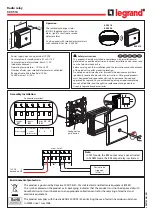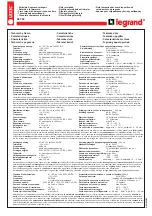
⎯
216
⎯
6
F
2
S
0
8
3
5
6.7 Maintenance
6.7.1 Regular
Testing
The relay is almost completely self-supervised. The circuits which cannot be supervised are
binary input and output circuits and human interfaces.
Therefore regular testing can be minimized to checking the unsupervised circuits. The test
procedures are the same as described in Sections 6.4.1, 6.4.2 and 6.4.3.
6.7.2 Failure Tracing and Repair
Failures will be detected by automatic supervision or regular testing.
When a failure is detected by supervision, a remote alarm is issued with the binary output signal
of FAIL (*) and the failure is indicated on the front panel with LED indicators or LCD display. It
is also recorded in the event record.
(*) Failure signals on the external circuits, namely the signaling channel and isolator circuit, can
be allotted to any of the binary output relays by the user. Failure signals of the signaling
channel are set to BO11 of the IO2 module as the default setting.
Failures detected by supervision are traced by checking the "Auto-supervision" screen on the
LCD.
If any messages are shown on the LCD, the failed module or failed external circuits can be
located by referring to Table 6.7.2.1.
This table shows the relationship between messages displayed on the LCD and estimated failure
location. Locations marked with (1) have a higher probability than locations marked with (2).
As shown in the table, some of the messages cannot identify the fault location definitely but
suggest plural possible failure locations. In these cases, the failure location is identified by
replacing the suggested failed modules with spare modules one by one or investigating and
restoring the monitored external circuits (the signaling channel and isolator circuit) until the
"ALARM" LED is turned off.
The replacement or investigation should be performed first for the module or circuit with higher
probability in the table.
If there is a failure and the LCD is not working such as a screen is frozen or not displayed, the
failure location is either SPM or HMI module.
Содержание GRL100-101A
Страница 8: ... 7 6 F 2 S 0 8 3 5 6 7 4 Resumption of Service 220 6 7 5 Storage 220 7 Putting Relay into Service 221 ...
Страница 223: ... 222 6 F 2 S 0 8 3 5 ...
Страница 228: ... 227 6 F 2 S 0 8 3 5 Appendix B Signal List ...
Страница 256: ... 255 6 F 2 S 0 8 3 5 Appendix C Variable Timer List ...
Страница 258: ... 257 6 F 2 S 0 8 3 5 Appendix D Binary Output Default Setting List ...
Страница 269: ... 268 6 F 2 S 0 8 3 5 ...
Страница 270: ... 269 6 F 2 S 0 8 3 5 Appendix E Details of Relay Menu ...
Страница 279: ... 278 6 F 2 S 0 8 3 5 ...
Страница 288: ... 287 6 F 2 S 0 8 3 5 Appendix G Typical External Connection ...
Страница 326: ... 325 6 F 2 S 0 8 3 5 Appendix J Return Repair Form ...
Страница 330: ... 329 6 F 2 S 0 8 3 5 Customer Name Company Name Address Telephone No Facsimile No Signature ...
Страница 331: ... 330 6 F 2 S 0 8 3 5 ...
Страница 332: ... 331 6 F 2 S 0 8 3 5 Appendix K Technical Data ...
Страница 343: ... 342 6 F 2 S 0 8 3 5 ...
Страница 344: ... 343 6 F 2 S 0 8 3 5 Appendix L Symbols Used in Scheme Logic ...
Страница 347: ... 346 6 F 2 S 0 8 3 5 ...
Страница 348: ... 347 6 F 2 S 0 8 3 5 Appendix M Multi phase Autoreclose ...
Страница 351: ... 350 6 F 2 S 0 8 3 5 ...
Страница 352: ... 351 6 F 2 S 0 8 3 5 Appendix N Data Transmission Format ...
Страница 358: ... 357 6 F 2 S 0 8 3 5 Appendix O Example of DIF and DIFG Setting ...
Страница 360: ... 359 6 F 2 S 0 8 3 5 Appendix P Programmable Reset Characteristics and Implementation of Thermal Model to IEC60255 8 ...
Страница 364: ... 363 6 F 2 S 0 8 3 5 Appendix Q IEC60870 5 103 Interoperability ...
Страница 377: ... 376 6 F 2 S 0 8 3 5 ...
Страница 378: ... 377 6 F 2 S 0 8 3 5 Appendix R Failed Module Tracing and Replacement ...
Страница 384: ... 383 6 F 2 S 0 8 3 5 Appendix S PLC Setting Sample ...
Страница 386: ... 385 6 F 2 S 0 8 3 5 Appendix T Ordering ...
Страница 392: ......
















































